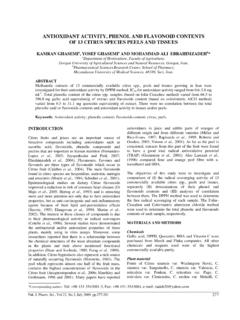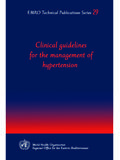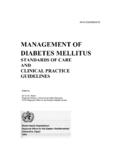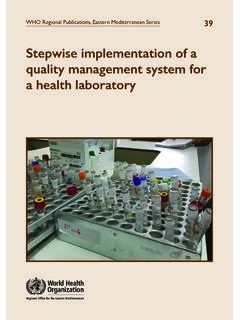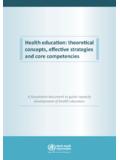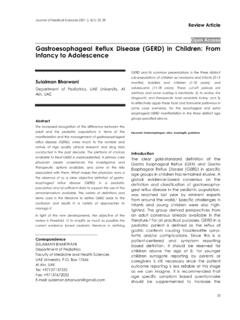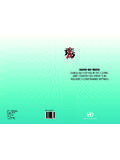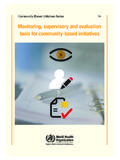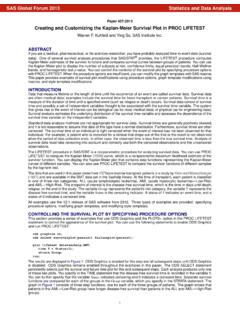Transcription of ORIGINAL PROF-2223 HOSPITAL WASTE MANAGEMENT;
1 Keywords: Medical WASTE , Medical WASTE Disposal, Infectious WASTE Disposal, Pathological WASTE Disposal, WASTE management ,INTRODUCTIONH ospital WASTE is Any WASTE which is generated in the diagnosis, treatment or immunization of human beings 1or animals or in research in a HOSPITAL . HOSPITAL WASTE is a special type of WASTE produced in small quantities carrying a high potential of infection and 2injury . There are serious health effects from public health standpoint if HOSPITAL WASTE is not handled WASTE management means the management of WASTE produced by hospitals using techniques that will check the spread of diseases through HOSPITAL 3waste . HOSPITAL WASTE consists of both risk WASTE and non risk WASTE .
2 Generally, risk WASTE includes infectious WASTE , pathological, pharmaceutical, sharps, chemicals, geno-toxic and radioactive wastes. Non-risk WASTE includes garbage and general day to day WASTE 4produced by food stuff leftovers and their developed countries have properly organized infrastructure of HOSPITAL WASTE disposal. A properly trained team is responsible for handling various operational procedures related to WASTE disposal like segregation, internal transportation, and final disposal. In developing countries, however situation is not good. There is lack of awareness regarding segregation, collection, storage and transportation and disposal 5procedures. Medical WASTE management has not received much attention in developing countries.
3 Segregation into risk and non risk WASTE is usually not performed. Workers have little awareness of hazards associated, and 6disposal techniques are poor. There is also lack of 7awareness at health policy and law case of cyto-toxic drugs, special care is needed during disposal, as contamination of handlers is easy, which can lead to ingestion and absorption causing Dr. Raheelah Amin, Dr. Rubina Gul, Miss Amina MehrabHOSPITAL WASTE MANAGEMENT; Practices in different hospitals of Distt. PeshawarORIGINAL PROF-2223 Professional Med J 2013;20(6): R, Gul R, Mehrab A. HOSPITAL WASTE management ; practices in different hospitals of Distt. Peshawar. Professional Med J 2013;20(6): Citation Introduction: HOSPITAL WASTE is a special type of WASTE which carries high potential of infection and injury.
4 Objectives: This study was conducted to examine Medical WASTE management Practices in different hospitals of Peshawar. Methodology: Simple observational, cross-sectional study. was conducted with a case study approach. Aug-Sep 2011, with selection of 15 hospitals. The data was collected through a pre-designed questionnaire with a checklist. Results: The study showed that 80% of the HOSPITAL personnel knew HOSPITAL WASTE and its management . There was WASTE management plan present in 30% of hospitals. Although hospitals did not quantified WASTE amounts but on average the amount of WASTE generated daily was kg/bed/day. Segregation into risk and non risk WASTE was done in of hospitals.
5 For non risk WASTE , disposal through Municipal Corporation was conducted in of the hospitals, while in , it was burnt. For risk WASTE , either it was buried or burnt. Proper incineration was carried out in only of the hospitals. Discussion: HOSPITAL WASTE generation, segregation, collection, transportation & disposal practices were not in accordance with standard guidelines. The average WASTE generation in most of the hospitals was almost equivalent to other under developed countries but less than that of developed countries. Conclusions: The HOSPITAL WASTE in the majority of hospitals of Peshawar was mismanaged. No proper HOSPITAL WASTE management plan existed except at few hospitals.
6 Serious health effects. It is needed to adequately 8educate them and to provide safety equipments. To achieve sustainable WASTE disposal system, the three R s- Reduce, Reuse and Recycle are generally used. They offer a simple guideline of the types of action to be taken. They are in general order of priority 9,10and also called the WASTE ministry HOSPITAL should prepare its own health management plan in accordance with national and international guidelines, specific to its unique 11requirements. It should be ensured that risks from HOSPITAL wastes to individuals and environment are 12minimized to certain proper management of health-care WASTE depends on various factors like proper planning, funding, administration and commitment at policy level.
7 If they are implemented properly, they can lead 13better effects for both individuals and environment. Proper WASTE management can significantly lower the infectious disease burden especially Hep B, C and AIDS, which spreads through I/V study was conducted to examine medical WASTE management practices in different hospitals of Distt. DesignSimple Observational, Cross-sectional study design (with case study approach) Time & PlaceIn Distt. Peshawar from Sep-Oct, 2011 in secondary and tertiary care hospitals of Distt. SizeA total of 15 hospitals were selected by convenient sampling. Both tertiary & secondary care hospitals were included. Personnel involved in WASTE management were interviewed.
8 Data Collection ToolStructured Questionnaire with check AnalysisMicrosoft Excel sheet was used for graphs & total of 15 hospitals were visited. Regarding awareness, 80% of the HOSPITAL personnel interviewed knew HOSPITAL WASTE management and also considered it important. In of the hospitals, the WASTE management staff had undergone a training program for HOSPITAL WASTE management . In 60% of the WASTE management teams, the members were trained for emergency conditions within the HOSPITAL while in 40% they were not. of the workers thought that safe disposal and segregation of the health care WASTE was an important issue. A HOSPITAL WASTE management team was present in majority of the health care facilities with 15-21 members present in 33% of the hospitals.
9 Meetings of the WASTE management team were conducted twice a month in of the hospitals to revise the WASTE management policies and update them according toThe health workers handling the transport, segregation and disposal of WASTE in most of the hospitals were provided with gloves and masks while only 20% were provided with other special equipment like leg protectors, boots and aprons. Only 40% of the hospitals color coded the WASTE for disposal while no such practices were observed in the remaining 60% of the hospitals. The facilities available for the WASTE disposal in different hospitals included burial, burning and incineration. Burial of the WASTE was conducted in of the hospitals, while in it was burned in open air.
10 Incineration was carried out in of the 2 Professional Med J 2013;20(6): WASTE management hospitals but no proper facility for disposal of radioactive WASTE was present. of the hospitals returned the pharmaceutical WASTE to its suppliers while of the hospitals did not. In 60% of the health care institutes, the janitors and sanitary staff were immunized against common communicable diseases, while in 40%, they were not. A Central Storage Facility was present in of the hospitals. In 60% of the health care enterprises, the head of every department was aware of the activities of the WASTE management team but daily monitoring by the WMO of the WASTE management plan was carried out only in 40% of the casesDISCUSSIONH ospital WASTE management is a significant environmental and social obligation, and hence requires a proper plan.
